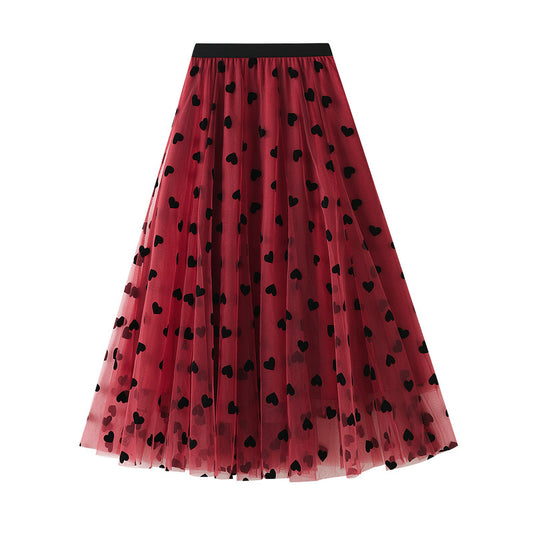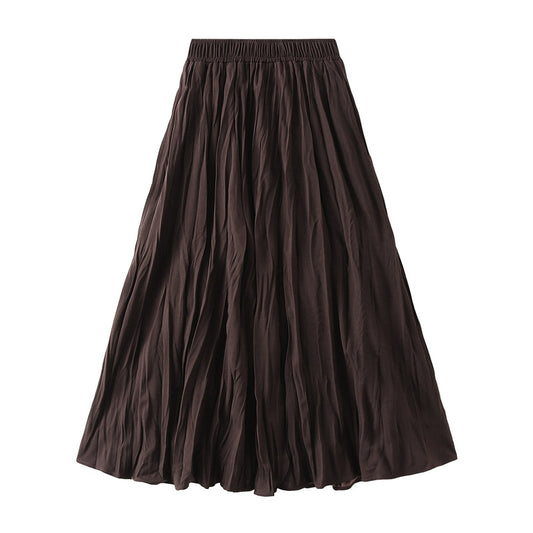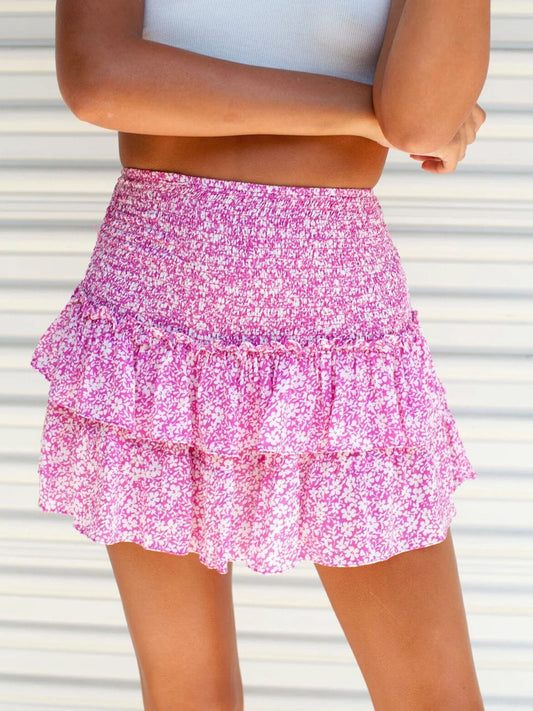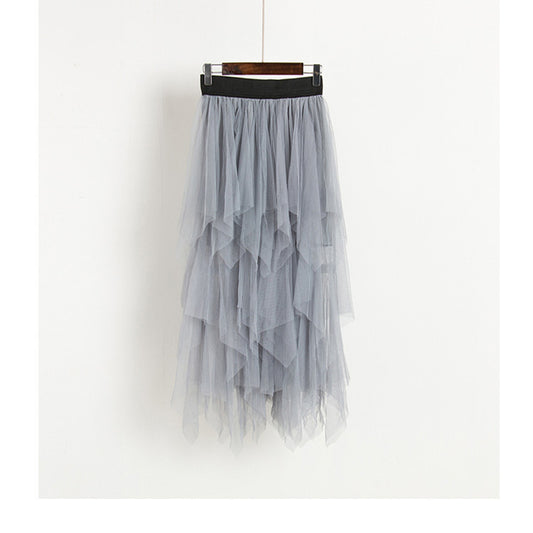-
High Waist Love Puff Mesh Flocking Midi Skirt
Regular price $42.00 USDRegular priceUnit price / per$42.00 USDSale price $42.00 USDSold out -
High Waist Slimming Pleated Mid-Length Big Hem A Line Skirt
Regular price $34.00 USDRegular priceUnit price / per$34.00 USDSale price $34.00 USDSold out -
Ruffled Printed Floral Bohemian Skirt
Regular price $33.00 USDRegular priceUnit price / per$33.00 USDSale price $33.00 USD -
Irregular Asymmetric Bottom Stitching Puffy Mesh Skirt
Regular price $17.00 USDRegular priceUnit price / per$17.00 USDSale price $17.00 USDSold out -
Princess Five Layer Ballet Dance Skirt
Regular price $27.00 USDRegular priceUnit price / per$27.00 USDSale price $27.00 USD -
Suede Irregular Asymmetric High Waist Zipper Button Skirt
Regular price $26.00 USDRegular priceUnit price / per$26.00 USDSale price $26.00 USD -
Retro High Waist Pleated Large Swing Skirt
Regular price $70.00 USDRegular priceUnit price / per$70.00 USDSale price $70.00 USD -
Curling Double Layer Pleated Skirt
Regular price $128.00 USDRegular priceUnit price / per$128.00 USDSale price $128.00 USD -
High Waist Irregular Asymmetric Faux Leather Stitching Leather Skirt
Regular price $40.00 USDRegular priceUnit price / per$40.00 USDSale price $40.00 USD -
Dot Sexy Split Midi Skirt
Regular price $34.00 USDRegular priceUnit price / per$34.00 USDSale price $34.00 USD -
Pleating Low Waist Lace Skirt
Regular price $53.00 USDRegular priceUnit price / per$53.00 USDSale price $53.00 USD -
Sexy Flattering Flounced Denim Skirt
Regular price $41.00 USDRegular priceUnit price / per$41.00 USDSale price $41.00 USD -
High Waist Zipper Satin Midi Skirt
Regular price $36.00 USDRegular priceUnit price / per$36.00 USDSale price $36.00 USD -
Retro Classic Wine Red Fleece Lined Matte Leather Skirt
Regular price $35.00 USDRegular priceUnit price / per$35.00 USDSale price $35.00 USD -
Three Dimensional Floral Gauze Mesh Embroidered Mid Length Skirt
Regular price $43.00 USDRegular priceUnit price / per$43.00 USDSale price $43.00 USD -
Faux Two-Piece High Waist Pocket Tennis Skirt Short
Regular price $54.00 USDRegular priceUnit price / per$54.00 USDSale price $54.00 USD -
Faux Leather Sexy Solid Color Split Lace up Sheath Slimming Skirt
Regular price $60.00 USDRegular priceUnit price / per$60.00 USDSale price $60.00 USD -
High Waist Package Hip with A Zipper Short Faux Leather Skirt
Regular price $22.00 USDRegular priceUnit price / per$22.00 USDSale price $22.00 USD -
High Waist Slimming Mid Length Satin Acetate Silky Skirt
Regular price $41.00 USDRegular priceUnit price / per$41.00 USDSale price $41.00 USD -
French Fashionable High Waist Half Length A line Leather Skirt
Regular price $62.00 USDRegular priceUnit price / per$62.00 USDSale price $62.00 USD -
Double Sided Pleated Gauze Skirt
Regular price $33.00 USDRegular priceUnit price / per$33.00 USDSale price $33.00 USD -
Solid Color Pleating Rubber Band Spring Fastener Sports Organ Pocket Skirt
Regular price $33.00 USDRegular priceUnit price / per$33.00 USDSale price $33.00 USD -
Solid Color Pleated Side Slit Sheath High Waist Long Skirt
Regular price $33.00 USDRegular priceUnit price / per$33.00 USDSale price $33.00 USDSold out -
Long Gauzy High Waist Mid Length Tulle Skirt
Regular price $41.00 USDRegular priceUnit price / per$41.00 USDSale price $41.00 USDSold out
Collection: Skirts
Skirts: Key Basics and Major Questions
Skirts rank among the oldest garments in fashion. Many people ask how these pieces have changed, which lengths are most common, and what fabrics producers use. In 2022, industry data showed that around 30% of lower-body apparel sold was labeled as skirts, which confirms their steady appeal. A skirt, in simple terms, is a separate item worn around the waist and extending down the legs. It can be short, knee-length, midi, or maxi. Reports say these garments remain popular worldwide, with new versions arriving each season.
- Definition: A garment that drapes from the waist downward
- Market share (2022): ~30% of lower-body sales were skirts
- Lengths: mini, knee, midi, or maxi in various fabrics
History and Leading Lengths
Researchers believe skirts, as a concept, predate many other outfits by centuries. Early societies often wrapped cloth around the waist to cover the legs. One study suggests that about 60% of ancient lower-body apparel looked like skirt shapes. Today, four main lengths stand out: mini (above the knee), knee (at or near the knee), midi (mid-calf), and maxi (to the ankles). A 2021 brand overview found that 35% of modern skirt lines used a mid-calf structure, making midi the single most frequent length in many mainstream collections. Each length has its own function.
Minis often link to casual or summer wear, knee-length suits everyday errands or moderate office dress codes, midi silhouettes typically adapt to daytime or semi-formal events, and maxi outlines (100–110 cm or more) appear at vacations or formal gatherings. In 2022, one big e-commerce platform stated that 20% of its fresh skirt arrivals were maxi designs, usually for warmer weather or resort styles.
- Four main lengths: mini, knee, midi, and maxi
- Data point: 35% of current lines are mid-calf shapes
- Maxi share (2022): ~20% of new items on a major online store
Fabrics and Materials in Production
A 2022 textile survey noted that 40% of skirts worldwide use cotton or cotton blends, 25% rely on synthetics such as polyester or spandex, 20% involve light weaves like chiffon, and 15% employ other textiles, such as wool, denim, or leather. This variety suits different climates and functions. Cotton or jersey knit appears in casual outfits, while a wool pencil design might be part of winter business attire. Some manufacturers add stretch fibers to improve movement in fitted outlines.
Chiffon or georgette shows up often in evening or special-occasion lines, while tweed or thick wool emerges in colder months for A-line or pencil shapes. Leather or faux leather made up about 5% of new launches in 2021, showing a smaller niche. Denim remains an important casual choice, taking around 10% of a department store’s 2022 skirt offerings in various lengths.
- Material breakdown: 40% cotton, 25% synthetics, 20% lightweight weaves, 15% others (wool, denim, leather)
- Denim portion: ~10% in one 2022 department store range
- Leather or faux leather: ~5% of new skirts in 2021
Key Silhouettes and Their Traits
A central question: which shapes lead the market right now? Common forms include A-line, pencil, maxi, mini, pleated, and wrap, each covering a distinct style need.
-
A-Line
Narrow at the waist, flaring gently toward the hem. In 2022, about 28% of skirts on a popular online site matched this outline. Suits many lengths, from knee to midi, using structured or flowing cloth. -
Pencil
Sometimes called slim or straight. A 2021 label analysis said 25% of skirts in office-ready lines were pencil shapes. Typically knee-length or midi, with minimal flare. Often includes a back vent to aid walking. -
Maxi
Extends near the ankles, often 100 cm or more. About 20% of new skirts at a major online store in 2022 were maxi silhouettes. Seen in bohemian or resort wardrobes and in formal lines. Some feature slits or layered effects. -
Mini
Sits above the knee, sometimes mid-thigh. A 2021 style check showed minis were 15% of new arrivals at a fast-fashion label. Tied to casual or youthful looks, but can also appear in runway collections with bolder cuts. -
Pleated
Characterized by repeated folds, can be short or long. A 2022 survey found that 10% of skirts across a multi-brand range had pleats, usually around the waist. Appears in school uniforms or as mid-calf designs in formal sets. -
Wrap
Wrap-around construction with ties, snaps, or buttons. About 8% of new skirts in 2021 used a wrap design. May include asymmetric hems or overlapping layers.
Fit, Comfort, and Practical Elements
Another question: how to choose a skirt that’s comfortable and suits one’s lifestyle? Waistbands—elastic or zippered—change the overall fit. Pencil outlines may reduce movement unless they have a vent or stretch factor, while A-line or flared cuts usually grant more freedom. A 2022 brand report stated that 35% of casual customers favored elastic waistbands. Pockets matter too: about 25% of new skirts in a 2021 department store overview had pockets, appealing to those seeking convenience. Length also affects function. Very short shapes might fit casual errands but not stricter offices.
A mid-calf piece can handle business tasks if paired with proper tops. Maxi silhouettes appear in hot climates or formal events, often with slits for easier walking. Many retailers offer sizes 0 to 14 or XS to XL, with some going further. A 2022 brand summary mentioned that 40% of mainstream stores provided extended sizes, up from 25% in 2018.
- Elastic waist usage: ~35% of casual lines (2022 brand report)
- Pocket presence: ~25% in a 2021 store listing
- Extended sizing rise: from 25% to 40% across major retailers (2018–2022)
Seasonal Patterns and Popular Trends
Demand shifts with the seasons. Warm months bring shorter lengths and lighter fabrics. A top e-commerce brand noted that mini and midi silhouettes represented 60% of summertime sales in 2021. Some cyclical trends, like 1990s denim minis, reappear. A 2022 poll of 500 shoppers said 19% wanted retro mini forms inspired by that era. Pleated mid-calf versions have also gained more attention.
A 2022 brand report showed a 12% growth in pleated mid-calf shapes for winter. Another theme includes cargo or utility designs, often with extra pockets or straps, which made up about 10% of skirts in a 2021 runway season, merging street style with function.
- Summer ratio (2021): 60% for mini/midi in hot weather
- Retro mini interest (2022): ~19% recalled 1990s denim
- Cargo approach: ~10% had multiple pockets (2021 runways)
Suitability for Various Dress Codes
Skirts adapt to many scenarios. For everyday outings, a jersey knit or simple cotton version might suffice. In an office, pencil or A-line silhouettes in structured materials appear often. A 2021 consumer poll mentioned that 36% of respondents considered a knee-length pencil shape their top pick for business attire. Meanwhile, maxi options in luxurious cloth can be used in black-tie or formal contexts, sometimes incorporating high slits or layered tulle.
A 2022 wedding guest guide stated that 15% of suggested looks for female attendees were skirts paired with dressy tops. Additionally, many schools opt for knee-length pleated shapes in plaid or a single hue, with a 2021 global uniform study revealing that 40% of uniform-requiring institutions used a pleated style around the knee.
- Casual option: cotton or jersey with an elastic band
- Office favorite: knee-length pencil or A-line in structured weaves
- Formal times: maxi or midi with special fabrics and accent elements
Fabrics, Care, and Lifespan
Each cloth needs its own care. Cotton or polyester blends typically allow machine washing at 30–40°C. Wool shapes may require special cleaning to avoid damage. Silk or delicate satin items need gentle hand washing or professional treatment. A 2022 brand guide found that 70% of skirts labeled “machine-washable” recommended a gentle cycle. Another 20% needed hand washing, while 10% were dry-clean only, mostly for pure wool, silk, or heavily embellished designs. Correct upkeep can keep an item for many years.
A 2021 overview said a well-made pencil shape could last about five years or more if cleaned properly. Ironing or steaming is vital for structured or pleated outlines. A 2022 e-commerce help page said 45% of customer queries related to preserving crisp pleats. Some guidelines suggest placing a cloth over the folds while ironing on low heat. Leather or faux leather typically needs a wipe with a damp cloth or specialized solutions, while denim can handle normal machine washing, though over-washing fades color more quickly.
- Machine-washable ratio (2022): ~70% for labeled items
- Dry-clean only: ~10% (wool, silk, or heavily decorated pieces)
- Longevity estimate: pencil shapes can last ~5 years with good care
Sustainable Aspects and Eco-Friendly Measures
As with much of modern apparel, some skirt collections emphasize green practices. In 2022, about 12% of newly released skirts on certain platforms contained organic or recycled fibers. Some highlight local manufacturing or minimal-waste cutting. A 2021 consumer poll stated that 27% would pay extra for items made from confirmed organic or recycled cloth. This push aligns with larger changes in the sector, with some labels refining patterns to reduce leftover scraps. Organic cotton or hemp blends also appear, catching the eye of people seeking a smaller environmental footprint. Merging timeless silhouettes (like A-line or midi) with eco-friendly materials allows for pieces that last multiple seasons.
- Sustainable fabrics (2022): ~12% used organic or recycled components
- Buyer willingness to pay more: ~27% for confirmed eco-friendly textiles
- Minimal-waste cutting: seen in certain forward-looking labels
Shopping Guidelines
Many buyers look at waist and hip measurements because a skirt’s fit depends on the waist area. Pencil shapes can cling to the hips, so picking the right size is crucial. Another point is length. Checking the product description for the exact measurement from waist to hem helps avoid items too short for specific events or too long for day-to-day tasks.
A 2022 brand help page said 55% of returns resulted from length or waist fit issues, indicating the importance of measuring. Linings also matter. Some items have partial linings to handle transparency or scratchy fabrics. A chiffon midi may need a knee-length lining to avoid see-through problems. Another detail is pockets: a 2021 department store list noted that 25% of new skirts included side pockets, while 10% used patch pockets.
- Key measurements: waist and hip for fitted shapes
- Length details: read centimeters from waist to hem
- Pocket presence: ~25% with side pockets (2021 list)
Global Reach and Growth
Skirts appear in many places, with large retailers in North America, Europe, and Asia offering varied selections. Some regions prefer maxi silhouettes, while others lean toward knee-length. A 2021 data report claimed that about 35% of women’s lower-body apparel in Europe and North America was made up of skirts, with certain Asian markets showing even higher figures.
E-commerce sees new releases often, reflecting seasonal changes in style and fabric. In a 2022 expansion note, one mid-range label said its skirt section grew by 18%, exceeding the 12% rise in other product groups. This sign shows ongoing shopper interest in fresh prints, shapes, and finishes. Runway watchers observe that each season brings new twists, like layered flounces or diagonal hems, but pencil and A-line remain steady favorites.
- Global ratio (2021): ~35% of women’s lower-body clothes in some regions are skirts
- Frequent e-commerce updates: new shapes every season
- 18% increase in skirt lines (2022): brand growth beyond other sections
Day-to-Night Versatility and Layering
One reason these garments stay relevant is their ability to shift from day to evening with small tweaks. A simple cotton midi can become dinner-friendly by adding polished shoes or bolder accessories. A knee-length pencil can go from office hours to a night event by swapping a plain blouse for something more dramatic. A 2021 style poll found that 40% of participants wore the same skirt from daytime to night at least twice per month, praising the piece’s adaptability. Layering with tights or leggings helps in cooler temperatures, giving warmth and a pop of color or texture. Tights add variety while still letting the garment shine.
- Day-to-night usage: 40% wore the same skirt in both contexts at least twice monthly
- Layering method: tights or leggings for chillier seasons
- Accessory change: swap footwear, top, or jewelry for a fresh effect
Cultural Settings and Uniforms
Although this text focuses on general usage, some cultural or religious norms require longer shapes that ensure below-the-knee or even ankle coverage. Others allow mini or micro silhouettes for festivals or nightclubs. A 2021 global uniform study found that 40% of uniform-mandating schools used a knee-length pleated shape, often in plaid or a solid tone. This diversity illustrates how each place or group has unique ways of wearing these lower-body garments. Certain workplaces with stricter guidelines might set a minimum length, ensuring employees look consistent. Creative offices can be more lenient on lengths, allowing mini or asymmetrical outlines.
- Modesty rules: some societies prefer longer lengths
- Uniform data (2021): ~40% use knee-level pleated silhouettes
- Office policies: some specify lengths for brand cohesion
Short vs. Long: Shifting Focal Points
Designers often discuss whether short or extended silhouettes will dominate each season. Fashion cycles through maxi or midi waves, then returns to above-the-knee shapes. In 2022, several brand lookbooks featured many maxi styles, perhaps tapping into a post-pandemic desire for relaxed fits. Others reintroduced micro-minis referencing early 2000s nostalgia. A 2021 brand statement noted that its maxi category grew by 25% over the previous year, while micro shapes grew by 15%. Both extremes can coexist, reaching different style preferences.
- Maxi spotlight (2022): ~25% growth in some brand lines
- Micro resurgence: ~15% citing early 2000s inspirations
- Coexistence: both short and long silhouettes attract unique audiences
Alternate View on Skirts
This article focuses on factual data, yet the points and statistics reveal a clear conclusion. Skirts remain a core part of modern clothing. They range from mini silhouettes that highlight the legs, to maxi versions that offer coverage and flow, plus knee and midi shapes for offices or daily wear. Recent sales data shows that many people appreciate these garments for their easy styling, comfort, and ability to suit diverse occasions. Because lengths vary from above the knee to floor-length, and textiles range from cotton to chiffon, these pieces meet a wide range of tastes.
A 2022 global report estimated that about 30% of women’s lower-body apparel purchases were still skirts, cementing their status. Consumers keep seeking new shapes, prints, and shades, while classic cuts—like a knee-length pencil or an A-line midi—hold firm. As trends shift each season, these silhouettes connect historical origins with modern twists, remaining a vital presence in wardrobes worldwide.
















































